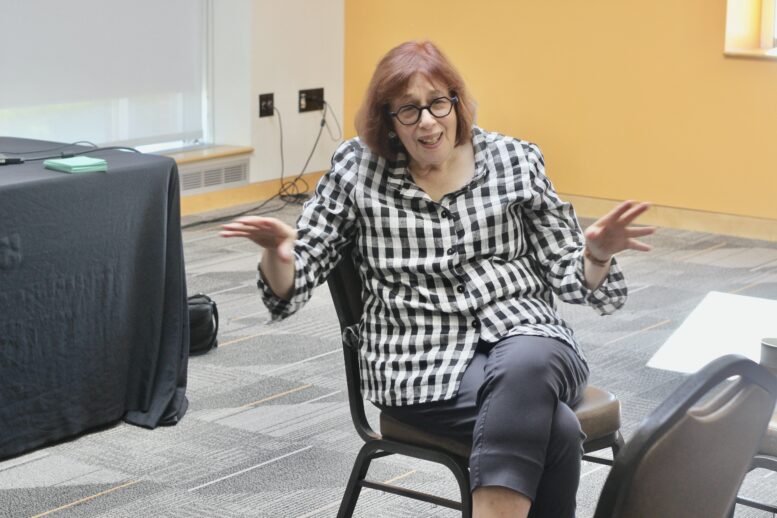By JULIE CARLE
BG Independent News
In recognition of Constitution Day, celebrated every year on Sept. 17, Pulitzer Prize-winning author Linda Greenhouse posed the question: “Who owns the Constitution?”
Ultimately, we the people, she said during Bowling Green State University’s recent Constitution Day lecture. While the country’s political polarization is playing out in many ways, the Constitution is one front that is a crucial one,” she said.
For 30 years as The New York Times’ Supreme Court reporter, Greenhouse had a front-row seat for the court’s proceedings and actions. “Not in my lifetime has the basic meaning of the Constitution been so contested,” she said.
While the 2022 Supreme Court decision about abortion is one of the recent issues that has brought the Supreme Court and the Constitution into question, it is not the only one. The Constitution meant one thing before June 24, 2022, when the Supreme Court overturned Roe v. Wade. After the Dobbs decision, “The Constitution now means we have a national patchwork of abortion restrictions and prohibitions that have turned thousands of American women into refugees fleeing their home states in order to obtain the medical care that was there by right for almost 50 years. That’s our Constitution,” Greenhouse said.
She quoted the majority opinion of Justice Samuel Alito who said, “We do not pretend to know how our political system or society will respond to today’s decision or overturning Roe and Casey. And even if we could foresee what will happen, we would have no authority to let that knowledge influence our decision.”
According to Greenhouse, Justice Elena Kagan responded after the ruling saying, “Justice judges create legitimate problems for themselves when they stray into places where it looks like they’re an extension of the political process or when they are posing their own personal preferences.”
The two opposing perspectives have one justice disclaiming any interest or responsibility for aligning the court’s jurisprudence with public sentiment, Greenhouse said. Another justice calls out “the danger posed by her colleagues arrogant and disingenuous.” She cautioned, “If over time, the court loses all connection with the public and with public sentiment, that is a dangerous thing for democracy.”
Greenhouse also cited Alito’s statement that Roe v. Wade “was egregiously wrong from the beginning.” However, she pointed out that the vote in 1973 was seven to two, not five to four, as many people thought; five of the justices in the majority had been appointed by Republican presidents.
The shift in the court’s power started a century ago when in the 1920s Congress gave the Supreme Court the ability to shape its own docket, which was a change from the previous schedule in which the court took every case that came along.
“It was a profound shift when the justices acquired the power to decide which cases to hear and which questions to leave unanswered,” Greenhouse said.
Usually, the Supreme Court deals with questions that lower courts have provided conflicting answers, with the goal that the law should mean the same thing across the country.
“When the court intervenes gratuitously in the absence of a conflict, we see something else, not the use of power to solve the country’s hardest problems, but power in pursuit of an agenda. And that was Dobbs,” she said.
There was no conflict among the lower courts on the constitutionality of abortion bans. The right to abortion before full viability was a settled precedent. “By taking Mississippi’s appeal, the court was using its power not to solve a problem, but actually to create one, to undo the precedents that stood in the way of individual states being able to decide politically what to do about abortion,” she said. “We embrace the concept of precedent for the predictability it provides that like cases should be decided alike.”
During the time the Dobbs case was pending, U.S. polls showed that two-thirds of Americans wanted to keep Roe v. Wade. After the court’s ruling, polls show that public confidence in the court has plummeted and support for the right to abortion has risen.
Greenhouse said the public used to accept the Supreme Court’s decisions even if they disagreed with them because they saw the court as the ultimate authority. Three years ago, Republicans and Democrats both approved of the Supreme Court by over 50% each.
A recent Gallup poll shows Republicans support the court at more than 70% while Democrats support is at 13%, the smallest level identified, she reported. “Now political public opinion about the court reflects the country’s extreme polarization,” Greenhouse said.
The court is no longer seen as a stabilizing force but as a “profoundly destabilizing one, a substantial divergence where the court is now from where most Americans are,” she continued.
When the Senate Republicans abolished the filibuster in 2017 in order to fill the seat they had held open during President Barack Obama’s last year in office, Justices Neil Gorsuch, Brett Kavanaugh and Amy Coney Barrett, who most likely wouldn’t have survived a filibuster, were narrowly confirmed.
“Our current politics have broken the connection between the Supreme Court and the American people,” Greenhouse said.
Additional cases before the court in the coming session this fall will be “a profound test for the Supreme Court … exercising its enormous power to achieve an agenda that lacks broad public support, which is a threat not only to the court but to democracy as well,” she said.
The docket also features fewer intensely personal cases, but instead focuses on the structures of our democracy, Greenhouse said.
“If not for the consequences of the court’s current actions, this could be an exciting Constitution Day, but it’s exciting in a different way—with new ideas on the table, a new generation is willing to look hard at the institution without the false consciousness of nostalgia for a past that never guaranteed the future. So when we ask ‘Who owns the Constitution?’ We have to insist on the only answer that a democracy can give–we do.”



